Although in absolute terms the budget allocations have grown after the introduction of the New Education Policy in 2020, the rise in the total expenditure of the central government does not see an equivalent rise in the percentage allocated to education.
By Adrian D’Cruz
Over the past decade, India’s higher education sector has witnessed a concerning decline in government investment. Despite a nominal increase in budget allocations following the implementation of the New Education Policy in 2020, the proportion of the education budget relative to the GDP has decreased steadily since 2014. Recent budgetary cuts, including a 7 per cent reduction in the interim budget for education, have particularly impacted higher education, with a notable 16 per cent decrease in allocations. A comparison with international standards highlights the magnitude of this decline: India’s expenditure on education falls significantly short of benchmarks set by countries like Brazil, South Africa, the United States, and the United Kingdom.
An analysis of the national funding scenario reveals a worrying pattern of underinvestment in universities: adjusted for inflation, per-student grants to central institutions have experienced a meagre 2.58 per cent Compound Annual Growth Rate (CAGR), which is a measure to show the growth of the investment in the product (in this case grants to central universities), over the past eight years. This trend underscores the mounting financial strain on public universities, further compounded by dwindling grants for research projects. Meanwhile, the proliferation of colleges, especially in the private sector, has not been met with commensurate financial support, further exacerbating the strain on public institutions. There has been a noticeable shift towards loans over grants for college infrastructure since 2018. It has, however, failed to alleviate this financial burden, with waning loan disbursements and rising college expenditures contributing to an increasingly unsustainable higher education framework.
The academic year 2021-22 saw the Gross Enrolment Ratio (GER) for higher education among 18- to 23-year-olds rise to 28.4 per cent, based on 2011 census projections. Despite this increase, recent reports indicate that only 45 per cent of graduate job seekers meet industry standards for employability. The expansion of higher education in the past decade, primarily driven by the growth of private colleges, has raised concerns about declining educational quality. Limited oversight from regulatory bodies like the University Grants Commission, as well as state and central governments, has allowed many universities to focus solely on examinations. The rise of online courses, emphasizing quantity over quality, has also aggravated this issue.
Under the BJP government, higher education in India has undergone significant modernization, exemplified by initiatives like virtual classrooms and vocational training programs such as Skill India, STRIVE, and SANKALP. The establishment of Eklavya Residential Schools for SC/ST communities and a Central University in Leh underscores the government’s efforts towards inclusivity. Additionally, the National Apprenticeship Promotion Scheme has witnessed a significant increase in participation, signalling a positive outcome of government policies. The National Education Policy (NEP) of 2020 emphasized a minimum education expenditure of 6 per cent of the GDP, and has also introduced new accreditation bodies to standardize autonomous institutions. However, despite total education spending exceeding 1 trillion rupees, its share in the GDP continues to dwindle below 3 per cent.
Education Budget
The share of the education budget as a percentage of GDP has continuously declined since 2014. Although in absolute terms the budget allocations have grown after the introduction of the New Education Policy in 2020, the rise in the total expenditure of the central government does not see an equivalent rise in the percentage allocated to education. Even the most recent interim budget for education has been slashed by 7 per cent, with a 16 per cent decrease in allocation for higher education in the country.
The NEP 2020 pledged 6 per cent of total expenditure as budget allocation to the education sector (both school and higher education) however the central government has fallen well short of that. If one compares the spending on education in other countries, the allocation is much less than the outlay by other equivalent nations such as Brazil (5.8 per cent), South Africa (6.2 per cent) and developed countries such as the United States (6 per cent) and the United Kingdom (4.2 per cent).
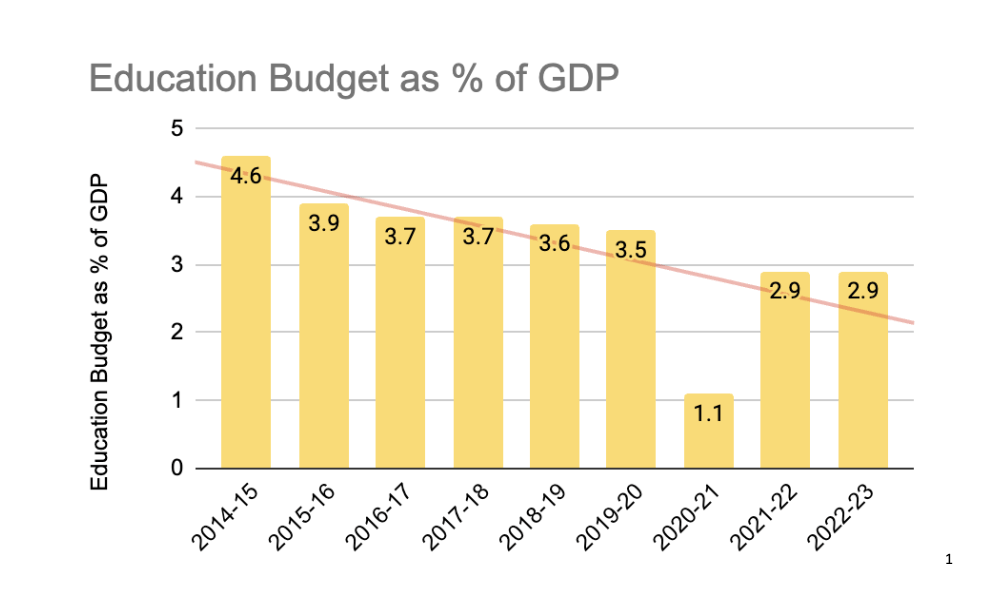
HEIs (Higher Education Institutions) are experiencing a consistent reduction in state financial support. India’s investment in research and development (as a percentage of GDP) has reduced from 0.8 per cent in 2008 to 0.7 per cent in 2018. This is much lower than the United States (2.8 per cent), China (2.1 per cent), Israel (4.3 per cent), and South Korea (4.2 per cent). As a result, India’s research output is lower compared to some other countries.
Analysis reveals a continual decline in state funding for universities, with the per-student grant to central universities showing a Compound Annual Growth Rate (CAGR) of 2.58 per cent over the past eight years, accounting for inflation. The claim of gradual underfunding of public universities is reinforced by the fact that Grants released by the UGC under minor and major research projects (science and humanities) have also been falling, according to answers provided by the Ministry of Education in Parliament in 2022. This major decline in funding to the UGC could also be due to the government’s plans of launching a new Higher Education Commission of India. The HECI will act as an umbrella body with four separate arms for: (i) standard-setting, (ii) accreditation, (iii) regulation, and (iv) funding.
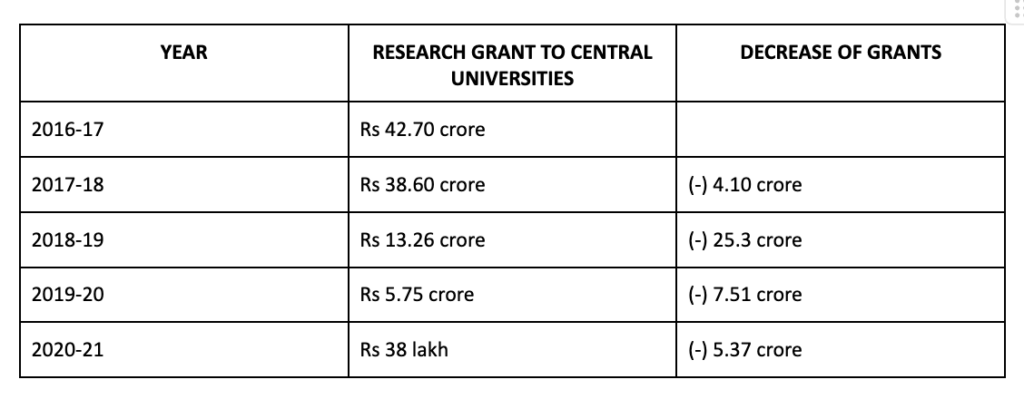
Private Colleges Growing but Enrollment in Govt Colleges Increasing
The number of colleges in the country have increased as compared to 2014-15 as seen in the table below. Although the rate of growth of private colleges (aided and unaided) has seen a 26 per cent rise as compared to a 16 per cent rise in state run/government colleges.

Moreover, the rate of student enrolments in government colleges far exceed the rate of student enrolments in private colleges. This points to a situation wherein private (aided and unaided) colleges are growing at a much higher rate, but student’s enrolment growth rate is higher in government colleges.

Average Higher Education Budget per Student
According to the All India Survey on Higher Education (AISHE) reports of 2014-15 and 2021-22, in 2014 the total number of student enrolments in colleges/higher education institutes in India was 3.4 crore and this rose to 4.3 crore in 2022, an increase of little less than 1 crore students (27 per cent increase in total students enrolled in HEIs). A simple analysis comparing the budget on higher education for these 2 years and the total number of student enrolments reveals that there has only been an increase of Rs 750 per student in the higher education budget in almost a decade. Per student budget spent in 2014-15 = Rs. 8107; in 2021-22 = Rs. 8857[2]
Remarkably, if one were to adjust these figures for inflation, it shows a 25 per cent decrease in average per student spend of the government on higher education.
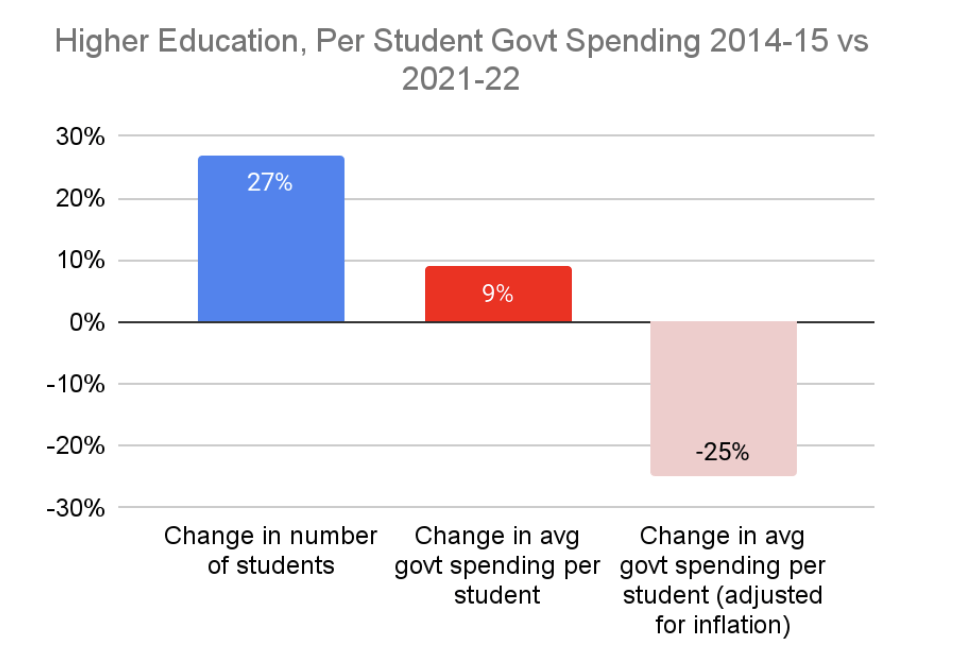
Budget Cuts Impact Scholarships for Marginalized
Analysis reveals a concerning trend in education expenditure within the Union budget, showing a decline from 4.1 per cent to 3.4 per cent between the fiscal years 2014-15 (actuals, A) and 2019-20 (budget estimates, BE). This reduction in budgetary allocation is evident not only in the diminished funds allocated for scholarships but also in a notable decline in the number of beneficiaries across various scholarship categories.
Amidst rising demand for educational support, recent data reveals concerning trends in scholarship provision for marginalized communities in India. Between 2015 and 2020, pre-matric scholarships for Scheduled Caste (SC) students experienced a decline of 8 per cent, while those for Other Backward Classes (OBCs) remained stagnant or saw marginal increases. During the same period, the number of SC students benefiting from post-matric scholarships notably decreased by 43 per cent, despite heightened demand. Similarly, budget allocations for Scheduled Tribe (ST) scholarships remained stagnant, leading to an 8.4 per cent reduction in the number of beneficiaries.
All these developments are taking place in the midst of government colleges hiking their fees to almost double and triple the costs. Across states like West Bengal, Delhi and Maharashtra, among others, have seen how college students protested in large numbers on the issue of a proposed or implemented fee hikes. Even IIT students protested against a proposed 900 per cent hike in fees for MTech courses. These fee hikes are not restricted to universities such as JNU, but include FTII, AIIMS, IIITs and other universities fully or partially run by the government. In an unequal world, public universities give everyone an equal opportunity and foster an exchange of ideas between people from varied backgrounds. The dreams of lower middle class, and poverty stricken families to achieve some level of financial freedom through a quality education have taken a huge dent in the wake of rising college fees, mess fees, hostel fees etc.
Private Colleges Growing but student enrolment in Govt Colleges Increasing
Private colleges have been on the rise, comprising 77 per cent of all colleges in 2014-15, while accommodating 67 per cent of total students. Meanwhile, government colleges, accounting for 23 per cent of colleges, were handling 33 per cent of all students, indicating an overburdened public higher education system.
Fast forward to 2021-22, private colleges have increased to 78 per cent of all colleges, yet they now only serve 65 per cent of students. Government colleges have decreased to 21 per cent of all colleges but still manage to educate 35 per cent of all students. This data from the AISHE Reports highlights a concerning trend of overburdened government colleges despite the proliferation of private institutions.
This means that the average number of students at a government college today is higher than in 2014, and the average number of students per private (aided and unaided) college is lesser than it was in 2014. The burden on government institutions is higher but the funding to these institutions has decreased in the past decade, pointing to an unsustainable public education apparatus.
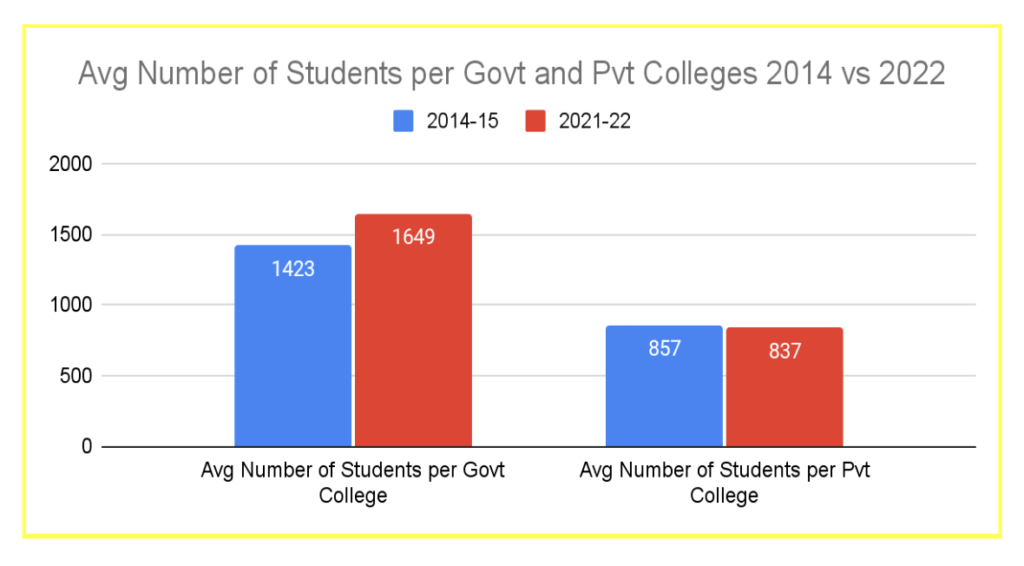
Declining Loans and Declining Grants for Universities
Since 2017, the central government introduced loans instead of grants for infrastructure of colleges but since 2019, the amount and the number of loans to colleges have declined steadily, while the college expenditures have increased and grants to colleges have not kept up.
The HEFA (Higher Education Finance Agency) was founded in 2017 to provide loans to Universities and Colleges for infrastructure improvements. But according to reports, they have fallen far behind the target of 1 lakh crore by 2022. In total, between 2017-18 and 2022-23, only 144 loans worth Rs 35,038 crore have been sanctioned by the HEFA. While the modes of repayment differ from one institution to another, the agency said “till date no institution has defaulted in repaying HEFA loans”. However, repayment obligations in the annual expenditures for colleges and universities have deterred them from accessing these HEFA loans as well. As per reports, only 26 of the 48 central universities have so far accessed HEFA loans totalling Rs 4,142 crore — averaging Rs 159.3 crore per university. Contrastingly, reports indicate that during the 11th and 12th five-year plans, all central universities received Rs 7,829.53 crore and Rs 9,346.29 crore, respectively.
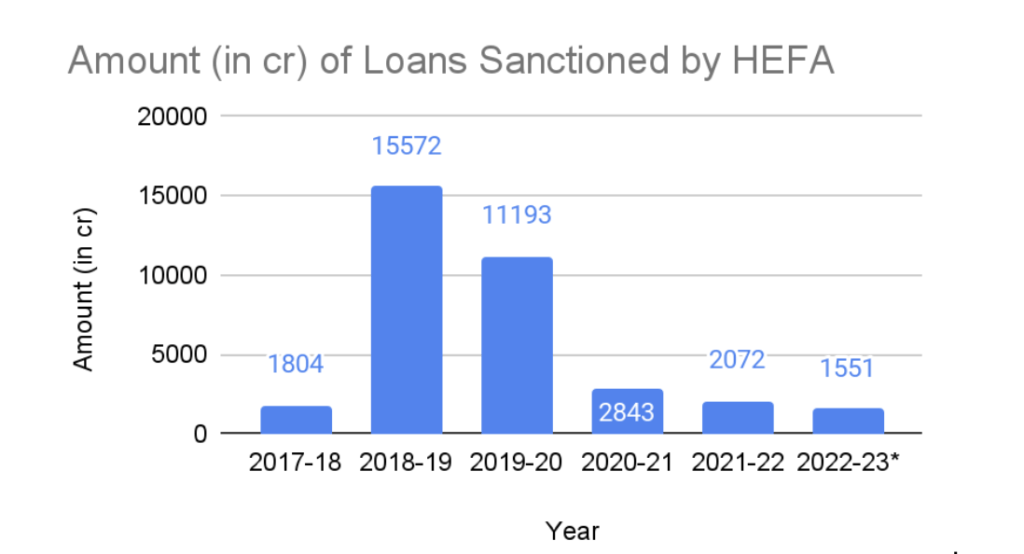
In retrospect, the trajectory of higher education in India over the past decade reveals a landscape increasingly marked by privatization, which, unfortunately, exacerbates exclusionary dynamics for vulnerable communities seeking access to higher education. Government policies have prioritized institutional autonomy over sustained financial support for public universities, compelling these institutions to rely on capital loans, inevitably leading to fee hikes and financial strain on students. Additionally, there has been a noticeable erosion of academic freedom within Indian Higher Education Institutions (HEIs), with faculty members encountering restrictions on teaching and research. Instances of disciplinary actions, including suspensions, terminations, and even arrests for dissenting views, reflect a growing climate of intolerance towards criticism of the government or prevailing ideologies. Despite promises, the current administration has fallen short of its commitment to allocate 6 per cent of GDP to the education sector by 2020. Without significant reforms, the Indian higher education system risks perpetuating isolated pockets of excellence while failing to adequately serve the nation as a whole.
Adrian D’Cruz works with the Wada Na Todo Abhiyan, a people-led campaign formed by over 3,000 civil society organisations in 2004, to promote governance accountability while reflecting the needs and voices of marginalised communities.
Image: Wikimedia
[1] Calculated through budget estimates and total budget expenditure accessed at https://www.indiabudget.gov.in/economicsurvey/index.php
[2] Budget in 2014-15 for higher education – 27,565 crore; Budget in 2021-22 for higher education – 38,351 crore;
Formula – Higher Education Budget divided by Total Students Enrolled

